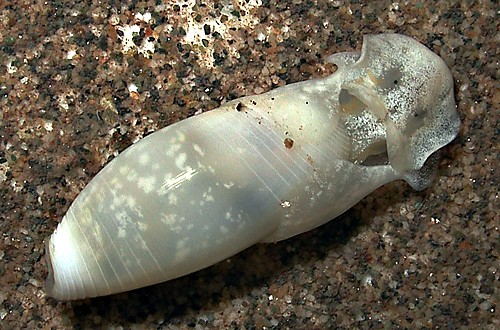| Home |
| Acknowledgments |
| Conventions |
| Glossary |
| Maps |
| References |
| Links |
| Articles |
| Thumbnails |
| Species
list |
| Family |
| Next
species |
Additional Photos

white

predation evidence

escape behavior

anemone predation

feeding

shell

egg mass
_______________
GALLERY

Aliculastrum debile (Pease, 1860)

| Maximum size: 23 mm
(extrapolated from shell length). Identification: This species has a translucent to opaque-white, spindle-shaped shell. There are spiral striae that become stronger and "step-like" basally and apically while the outer lip rises above the apex forming a notched "spout." Shells from Midway Atoll are broader than those from the main islands. The animal is translucent-gray variably flecked with opaque white. White flecks show through the shell in some. It may be distinguished from Weinkauffia ukulele by its more sharply "stepped" apical striae, more prominent apical "spout" and lack of narrow spiral pigment bands in the shell. Natural history: Aliculastrum debile is one of the most common sand-dwelling haminoeids in Hawaii. However, it is seldom seen since it is nocturnal and buries itself during the day. Even at night, it may spend much of its time crawling just beneath the surface of the sand leaving short trails reminiscent of those produced by terebrids. However, it probably emerges to mate and feed. (Note 1) It can be found in protected to moderately exposed locations and occurs in mixed habitats, open sand and Halimeda kanaloana beds from < 1 to 17 m (< 3 to 56 ft). Dredged shells at the Bishop Museum extend the depth range to at least 183 m (600 ft). When threatened by predators such as Philinopsis speciosa, it can swim strongly by flapping its parapodia. (Note 2) It appears to feed on microbial films of uncertain composition and it lays a spherical, white egg mass that is anchored in sand. (Note 3) The eggs hatch in about three days in the laboratory. Distribution: Big Island, Maui, Oahu, French Frigate Shoals, Pearl & Hermes Reef and Midway (also Johnston Atoll): also known from French Polynesia. Taxonomic notes: This species is listed in Kay, 1979, Kay & Schoenberg-Dole, 1991 and Severns, 2011 as Atys debilis. It was first reported from Hawaii in Pease, 1860. There is some possibility that the slightly more inflated shells from the Leeward Islands might prove to be a separate species. Atys cornuta Pilsbry, 1917 is a synonym (Kay, 1979) and it is also listed under that name in Edmondson, 1946, Quirk & Wolfe, 1974, and Tinker, 1958. On-line sources may also list it as Aliculastrum debilis. Photo: CP: spotted; 12 mm: Hekili Point, Maui; Nov. 11, 2004. Observations and comments: Note 1: In addition to those found beneath the sand, we've observed several on the surface at night including at least one copulating pair. Rarely, we've also seen them on the surface by day when visibility was reduced by silt or clouds. Note 2: In 2006, PF photographed what appeared to be a deposit of fish fecal material that contained large numbers of intact Aliculastrum debile shells. (see photo) It also contained test and spine fragments from the sea urchin Echinothris calamaris and a few prosobranch snails. The species that produced the fecal material could not be determined but the contents suggest that a generalized invertebrate feeder such as a trigger fish may have been responsible. The large number of intact shells suggests that whatever ate them was selectively feeding on the species (perhaps due to availability during a population peak?) and swallowing the animals whole. Perhaps, some fish are significant predators? Note 3: In September, 1990 an animal held in a dish with sand was observed laying eggs. The eggs were extruded from beneath the sand through a small hole and the mass inflated "balloon-fashion." When done, the animal crawled off beneath the sand anchoring the mass with its mucous trail without emerging onto the surface. |
| Thumbnails |
Species
list |
Family | Next species | Top |